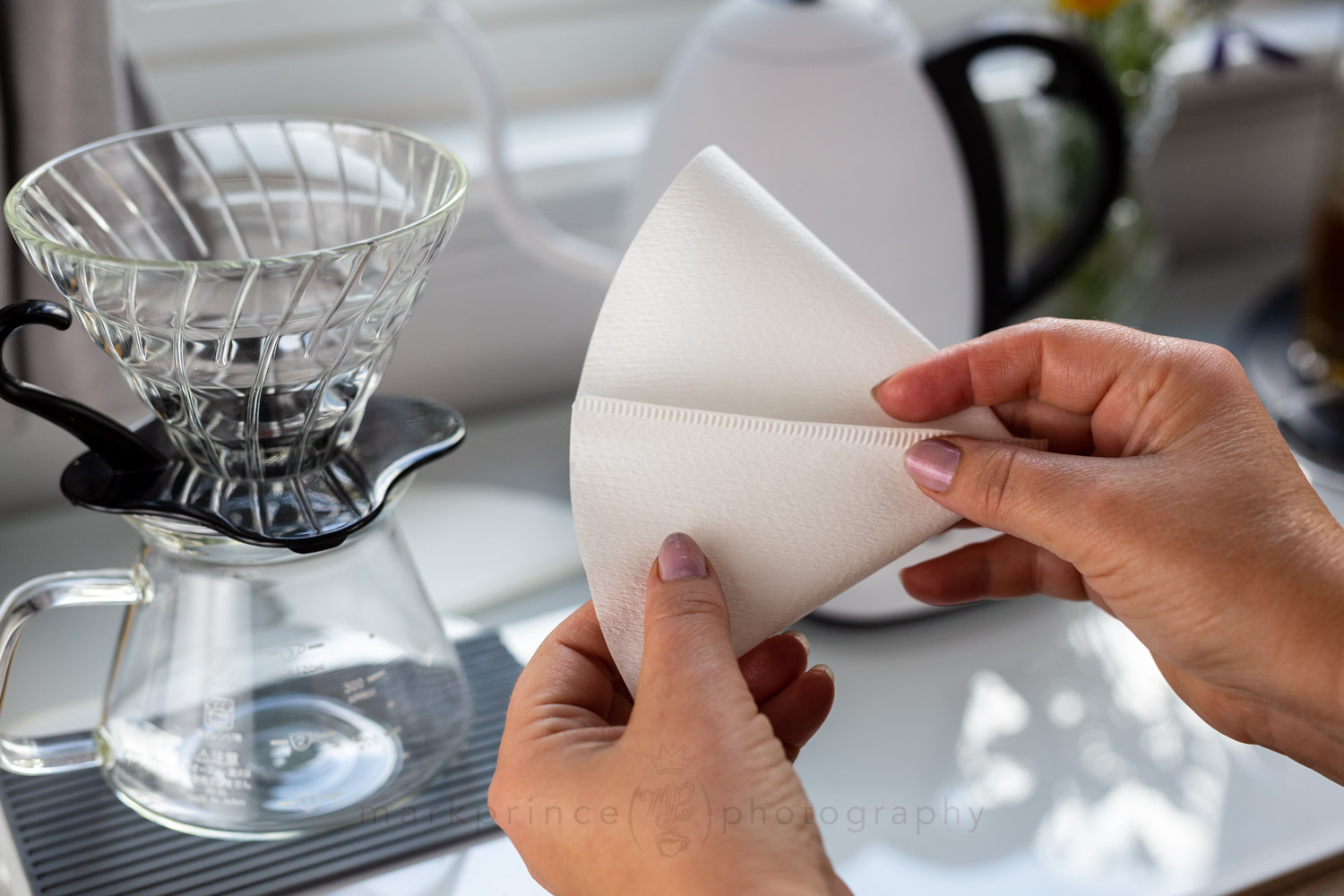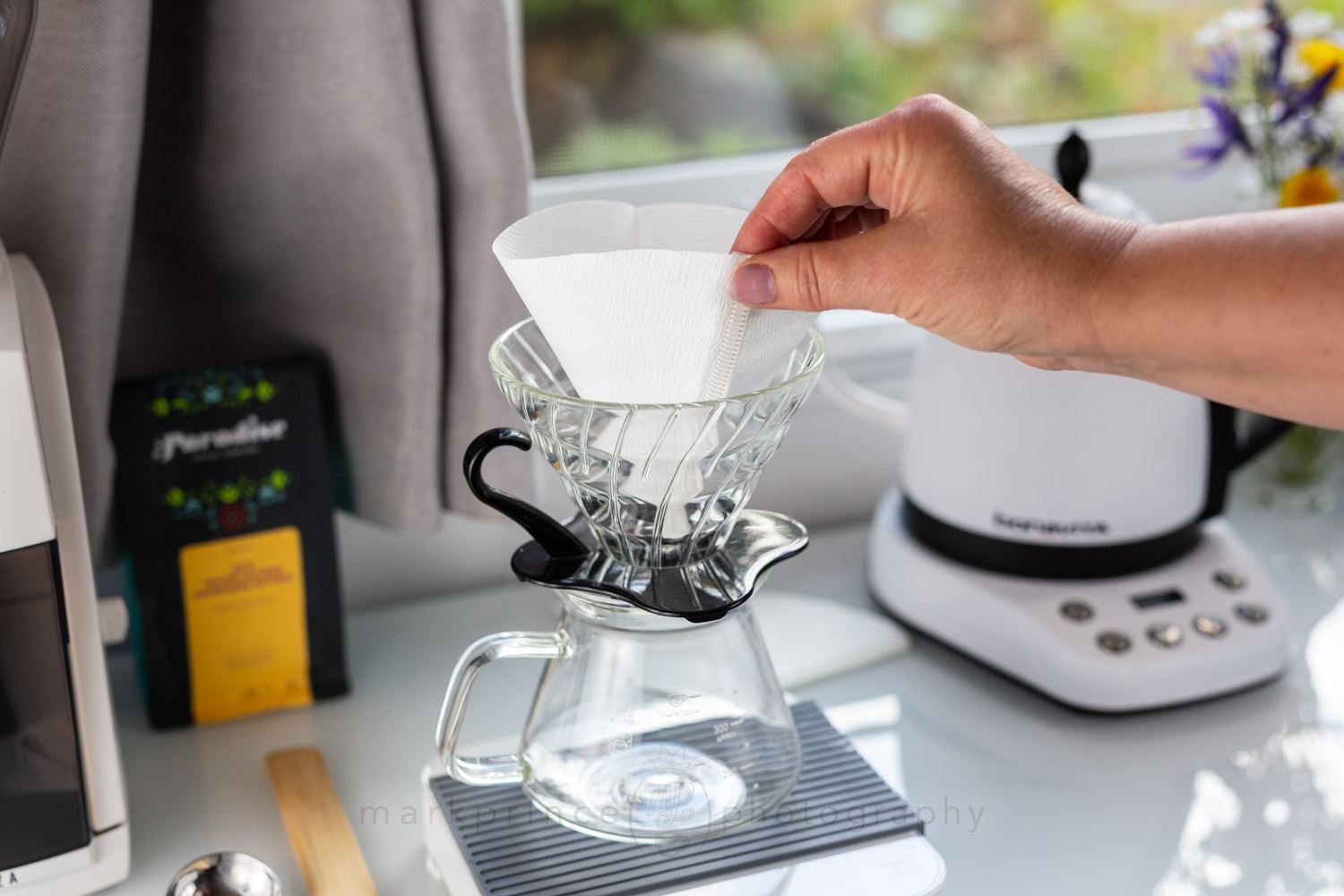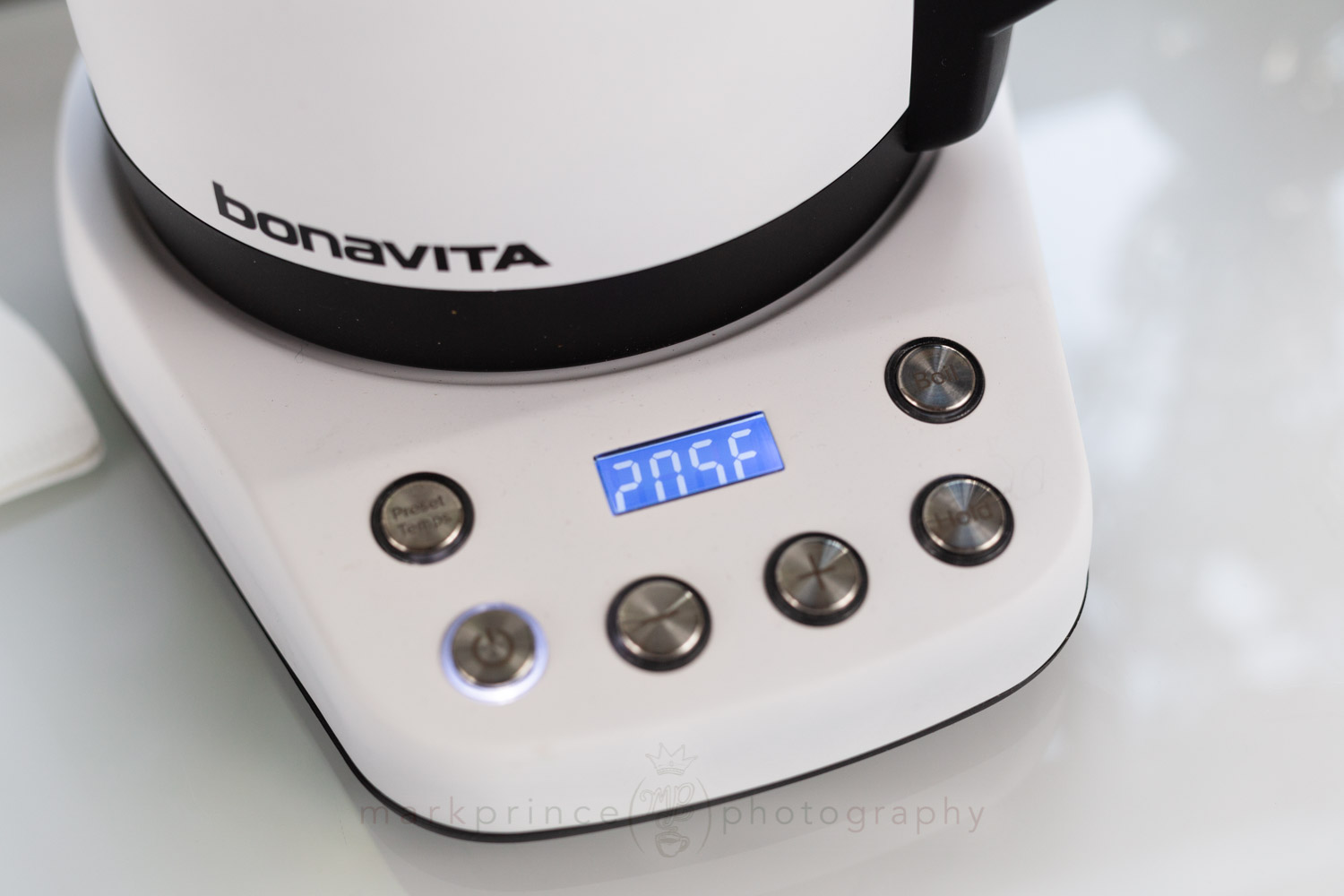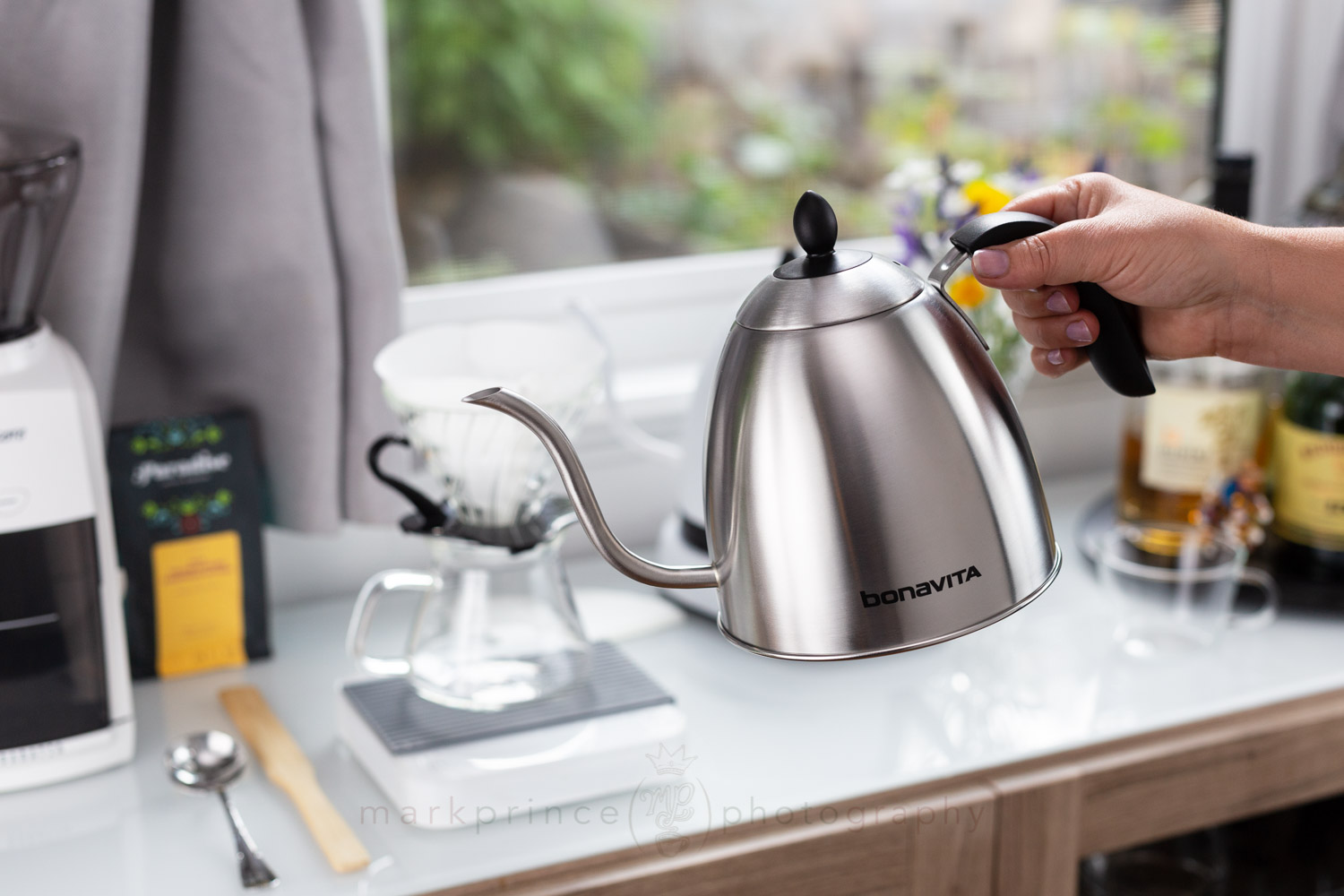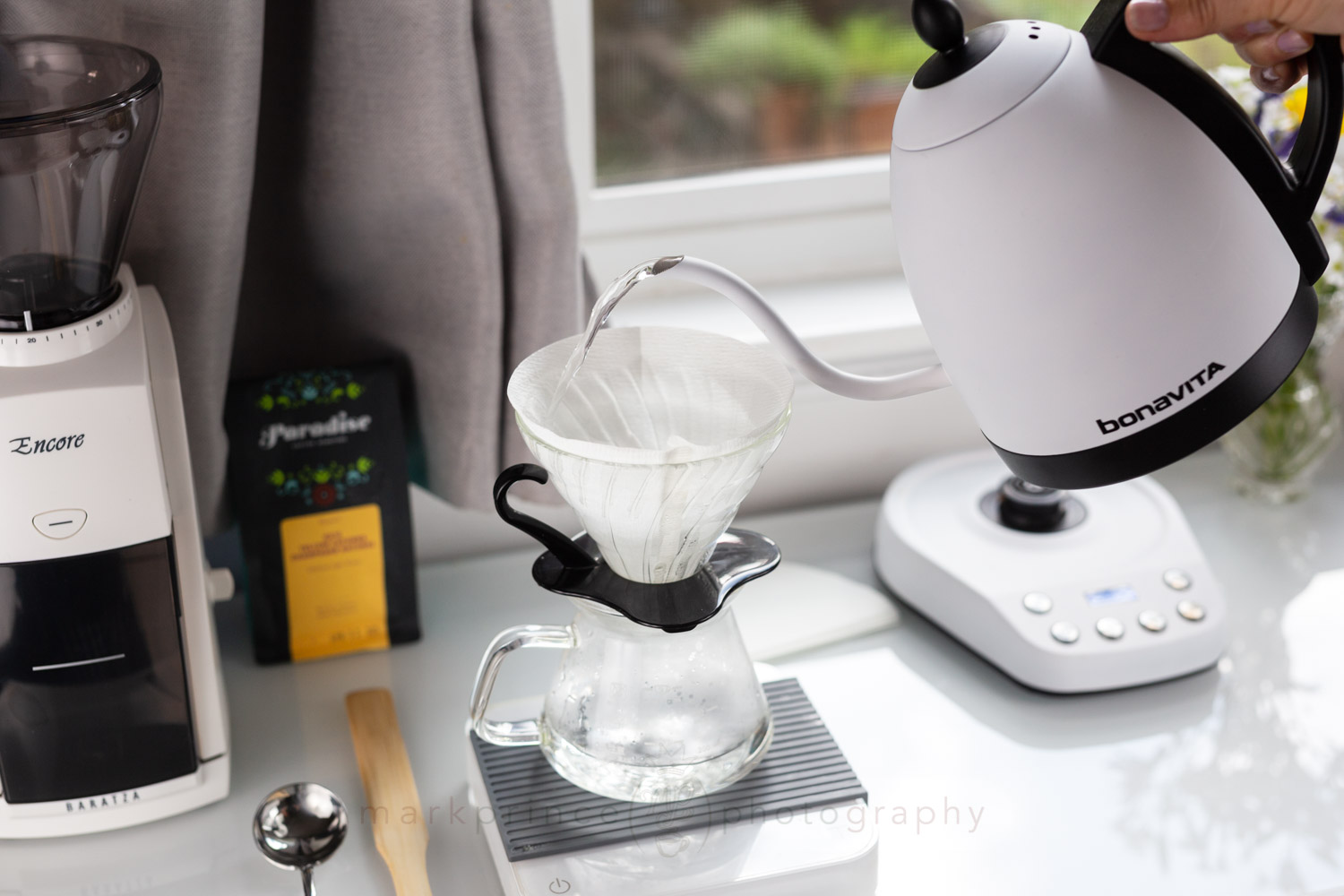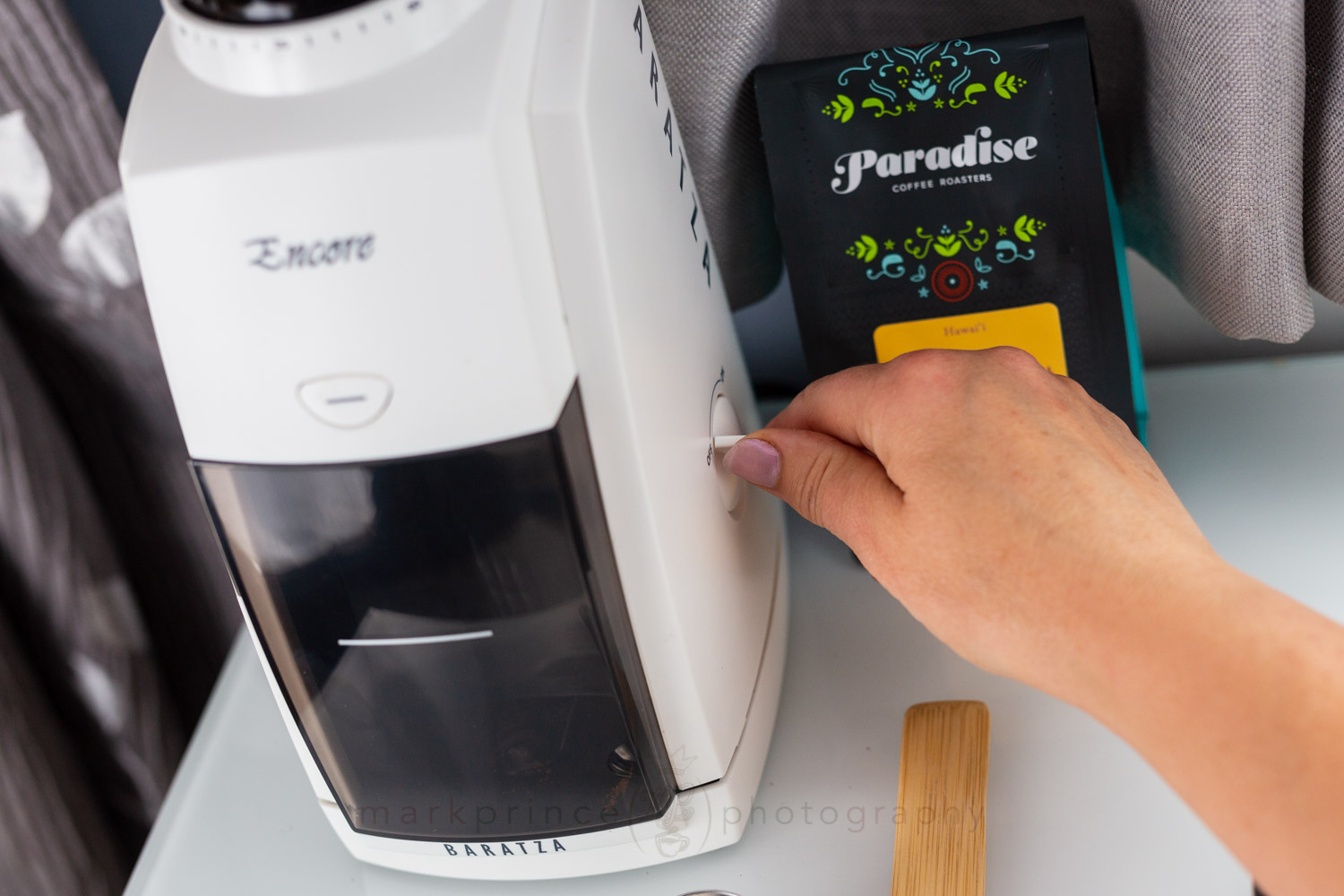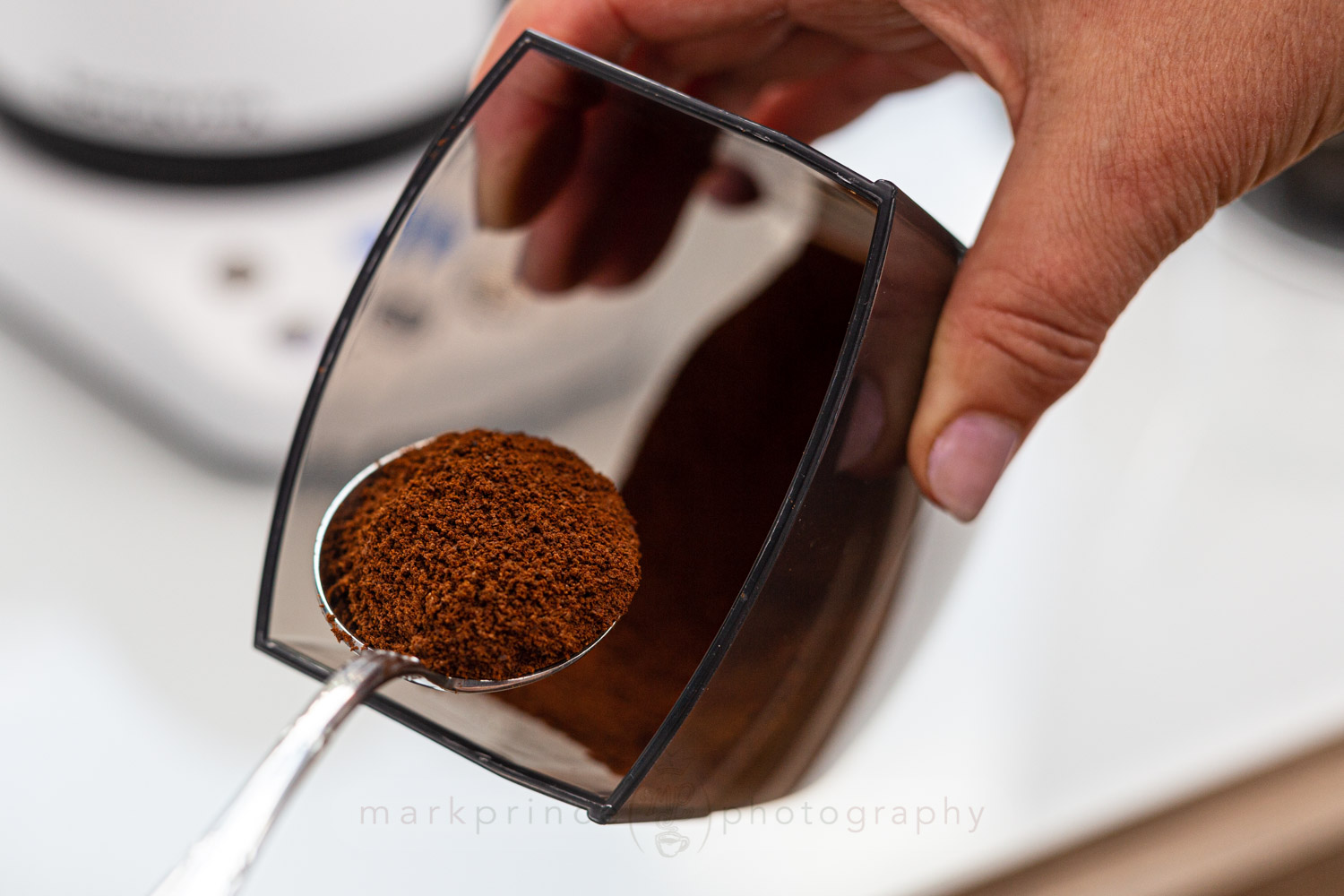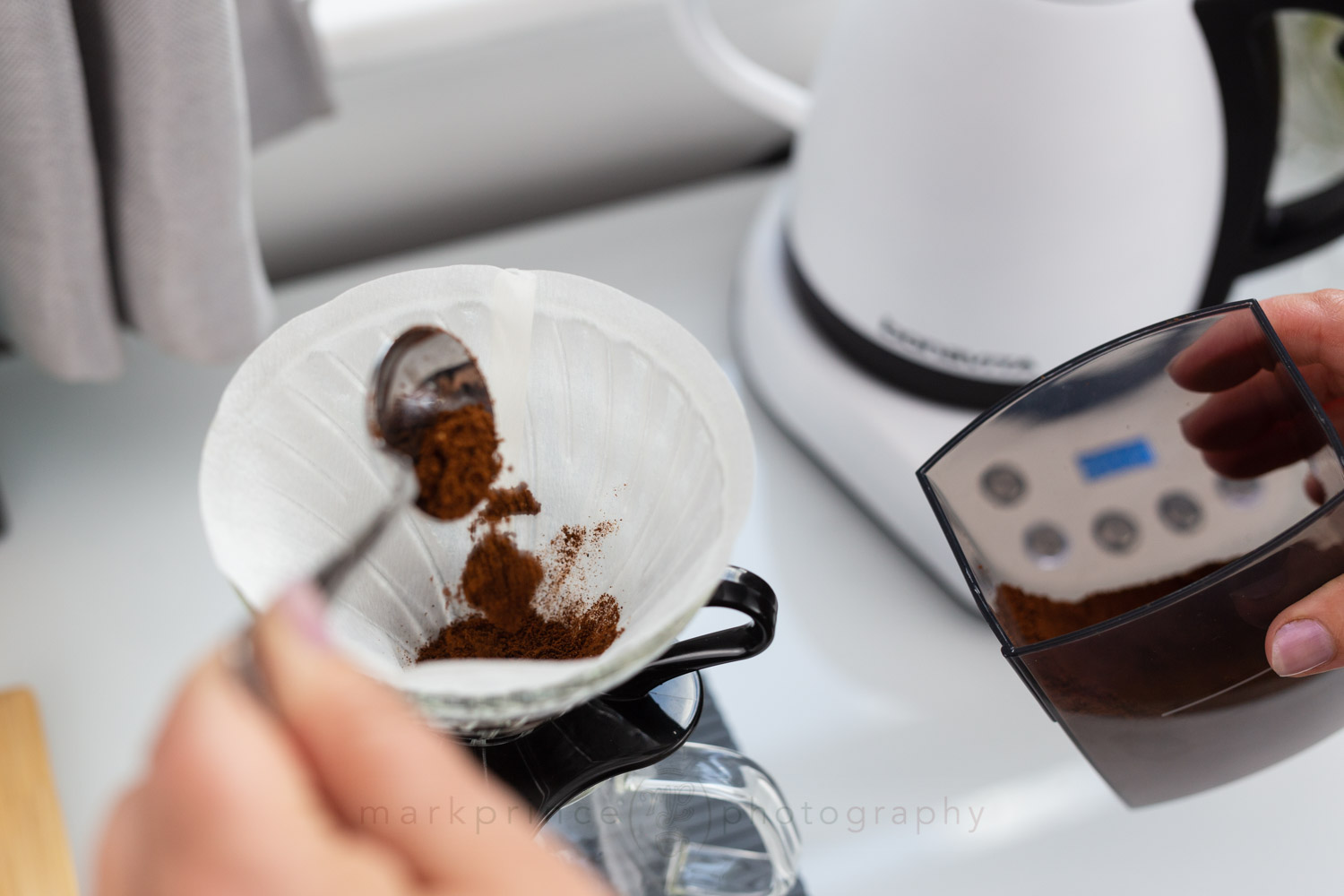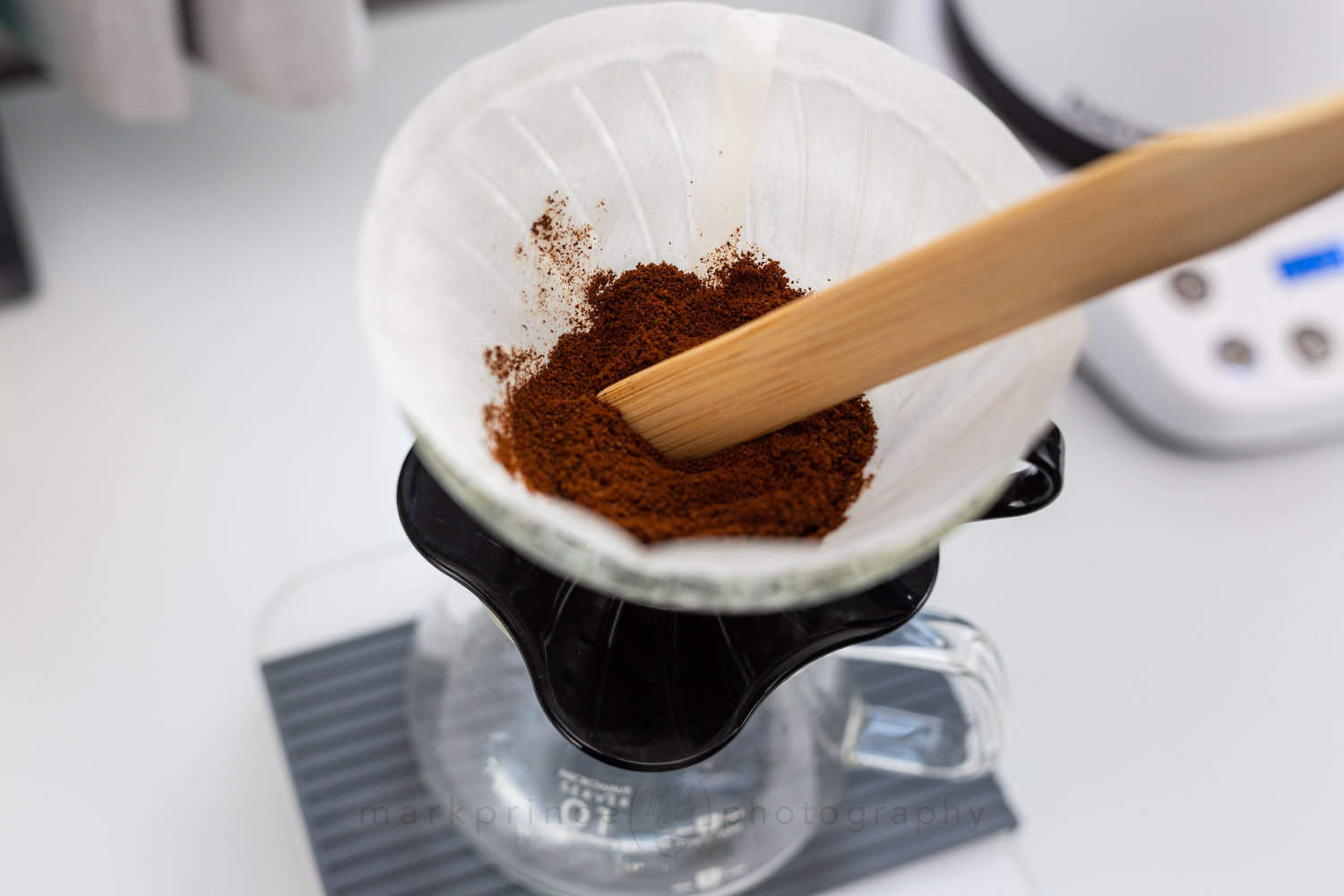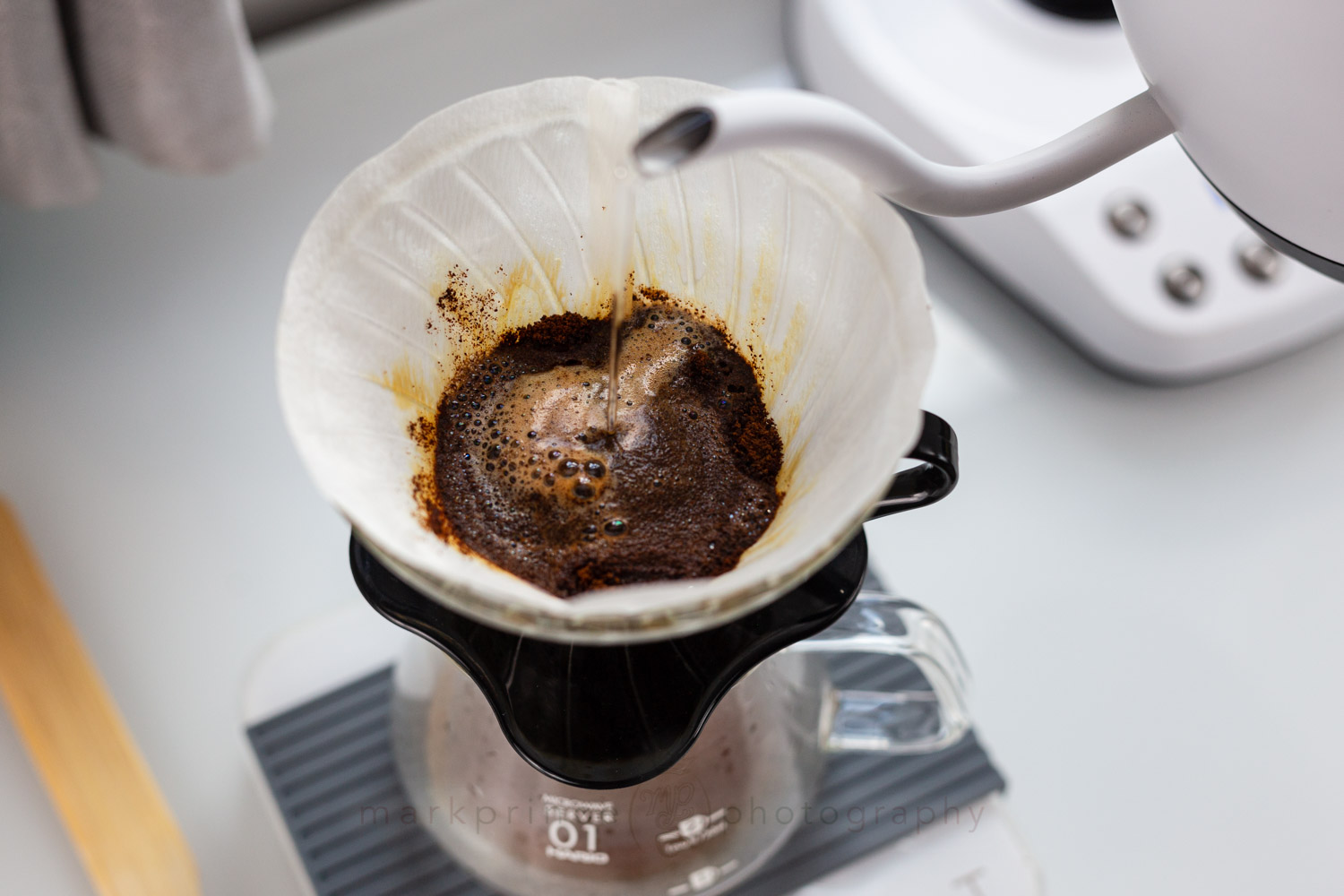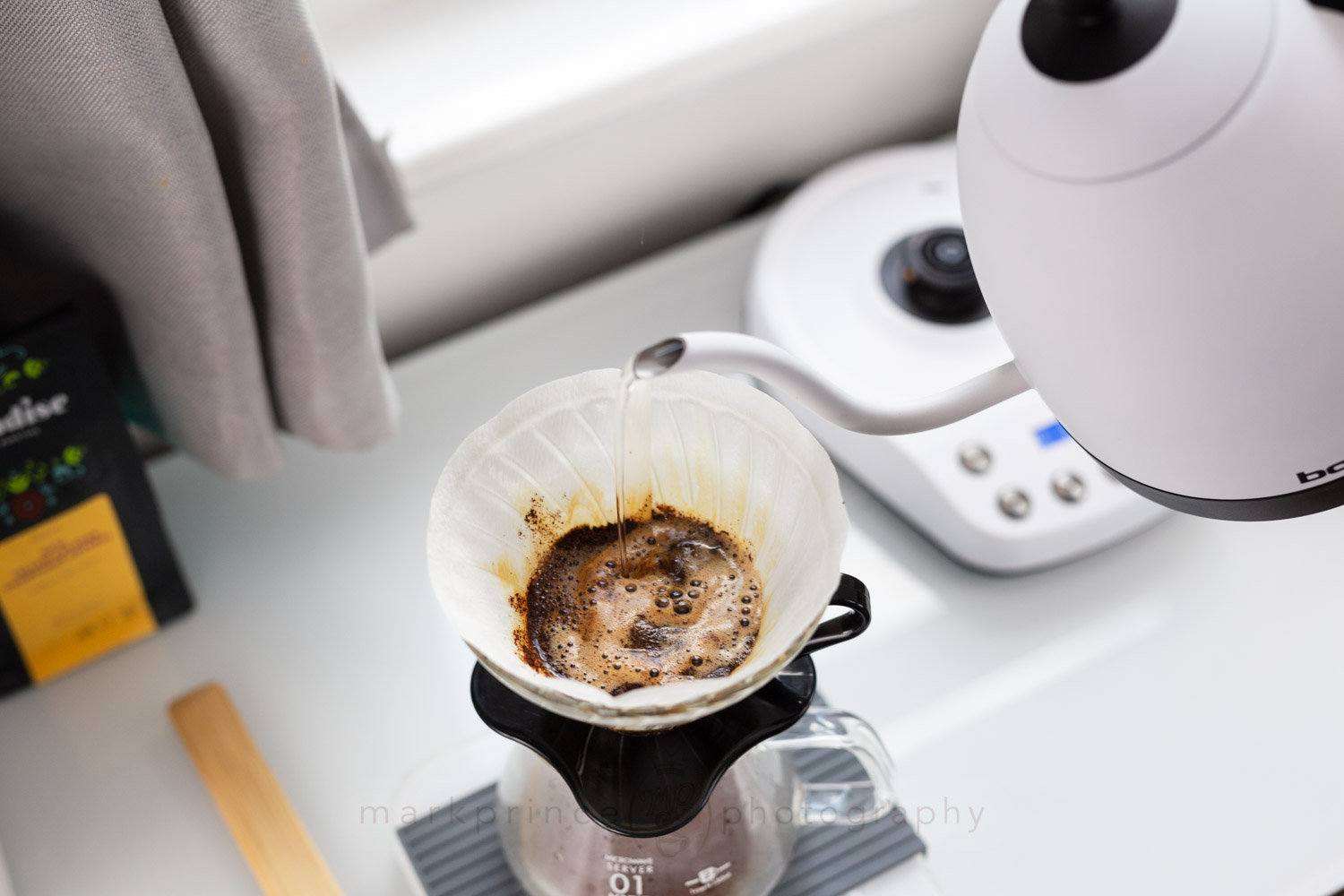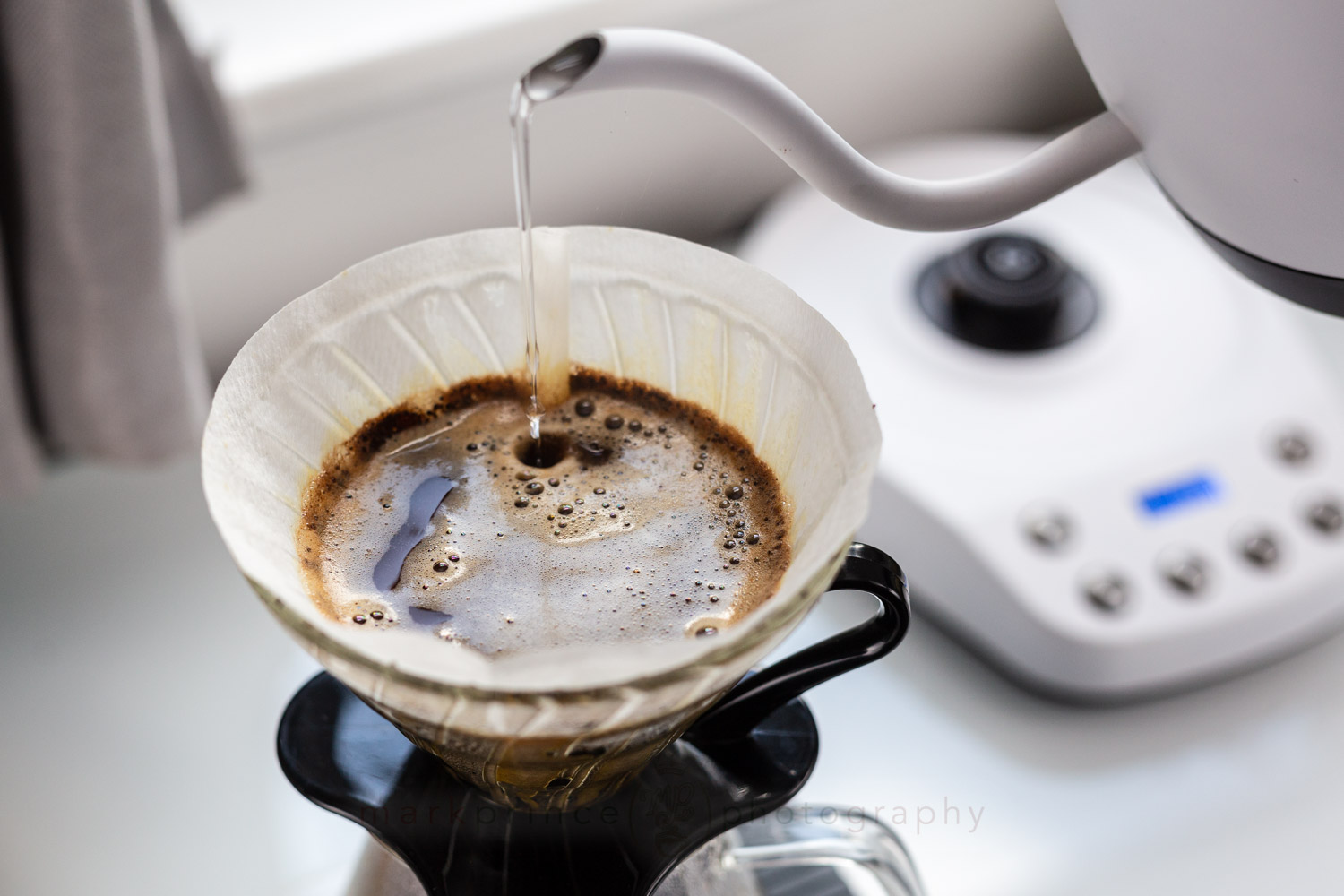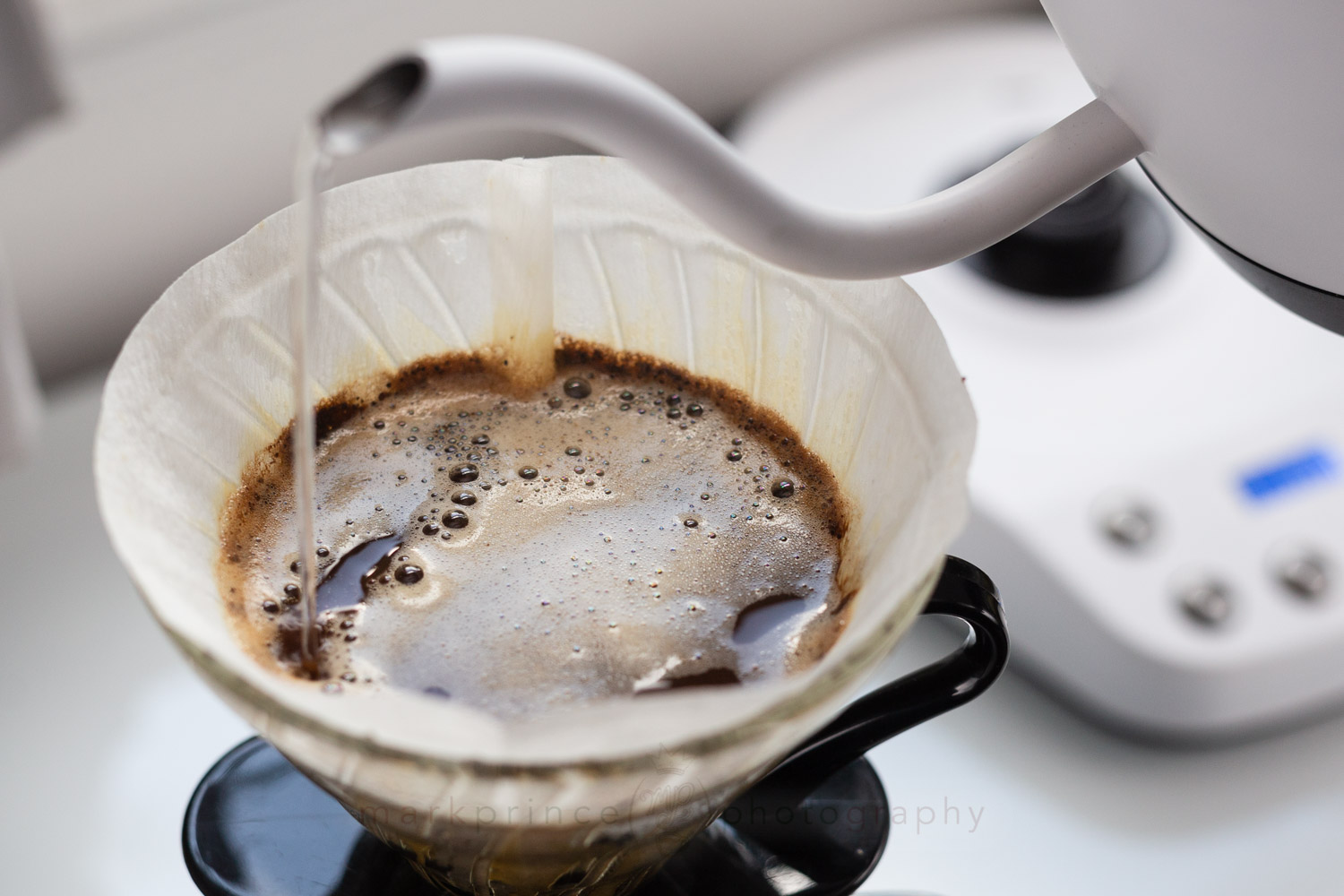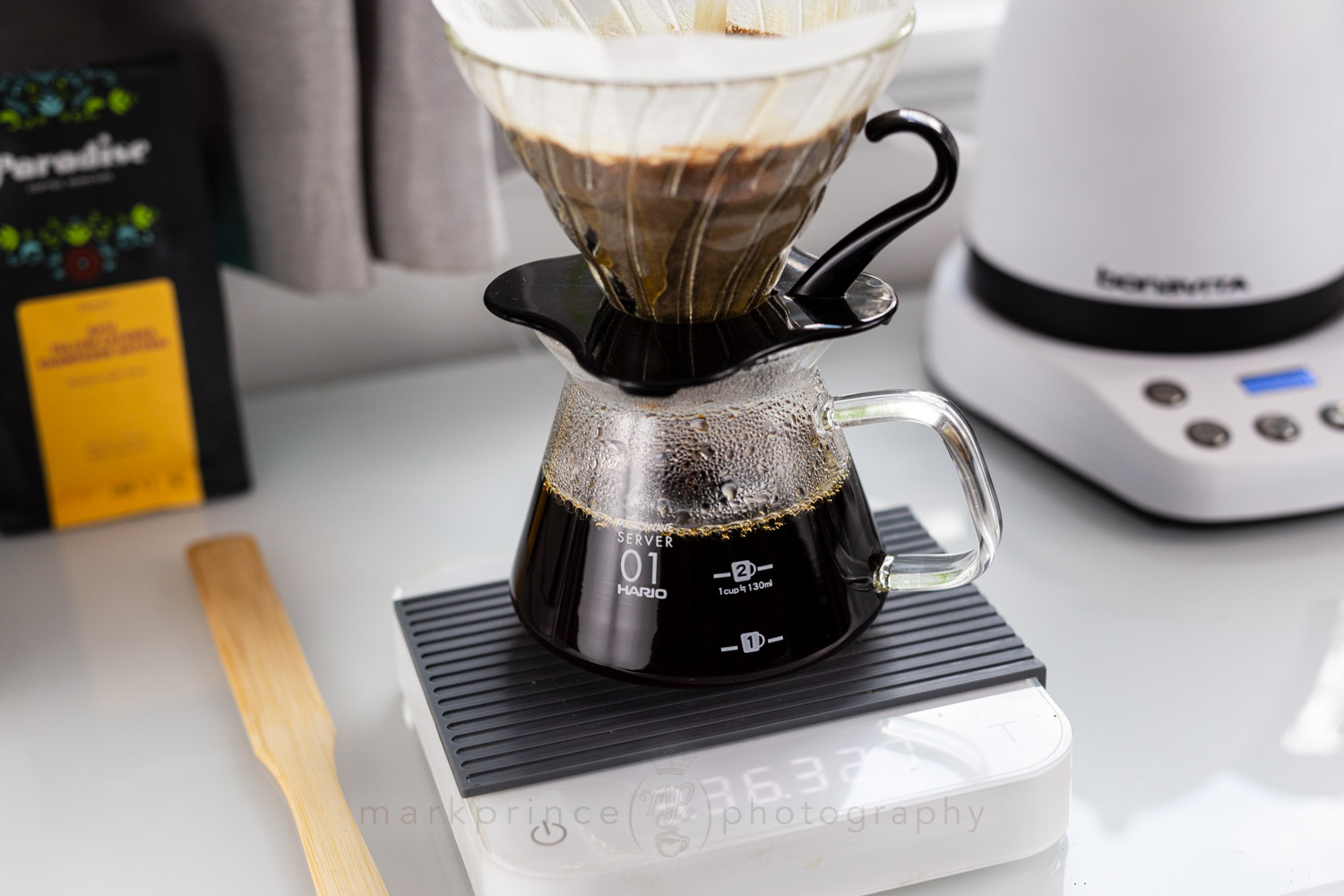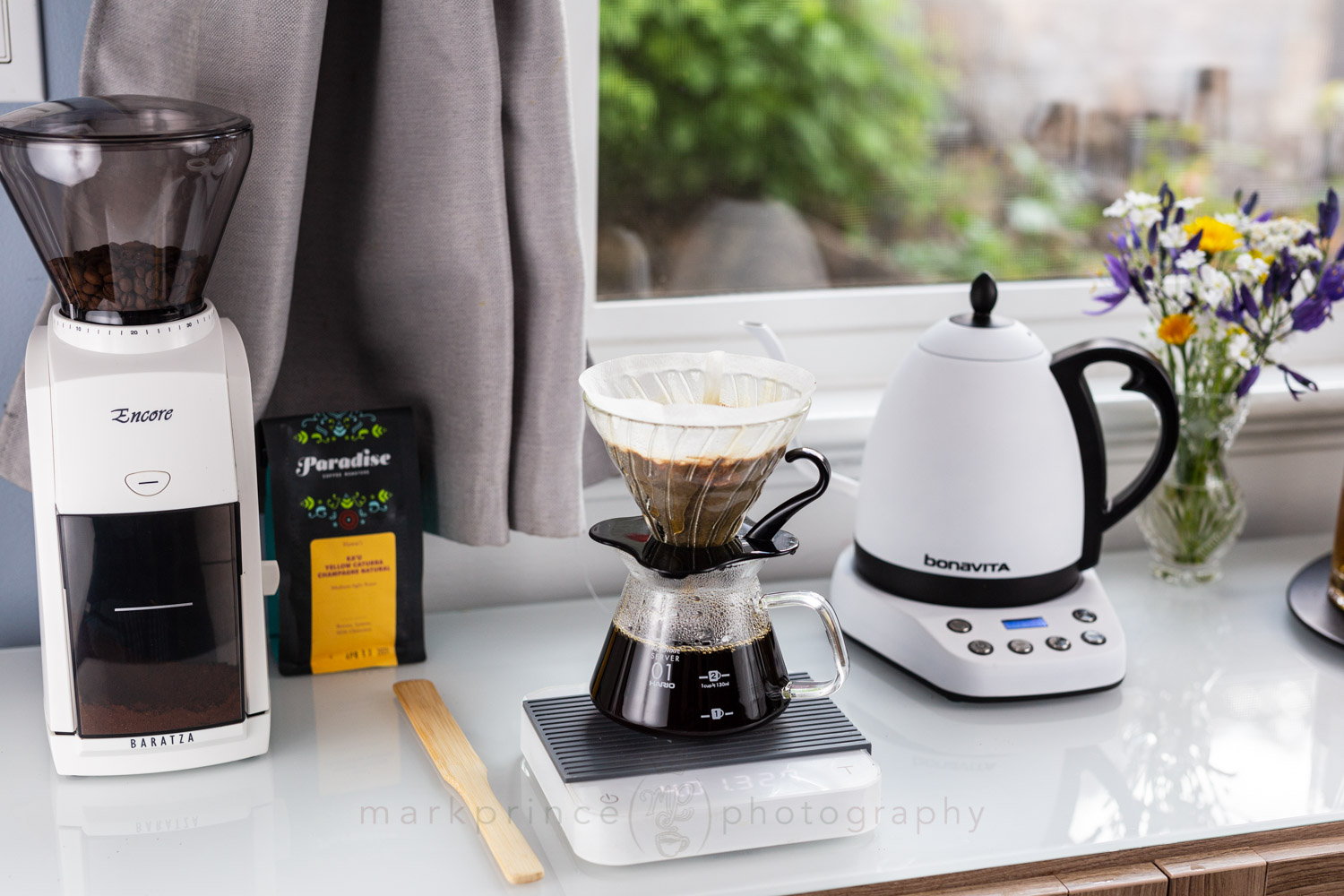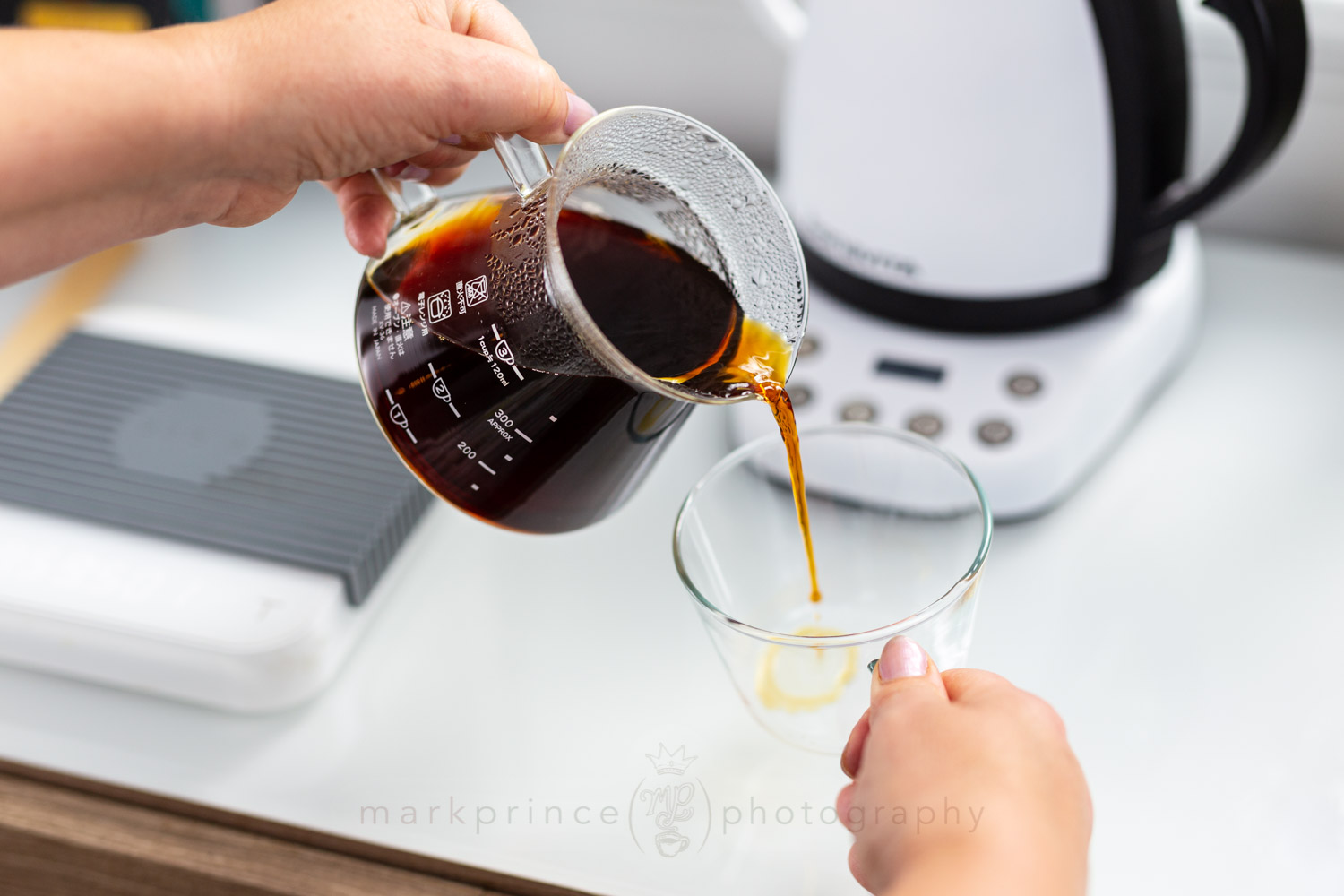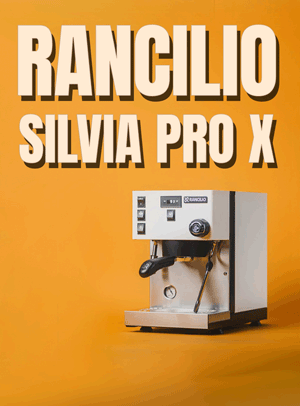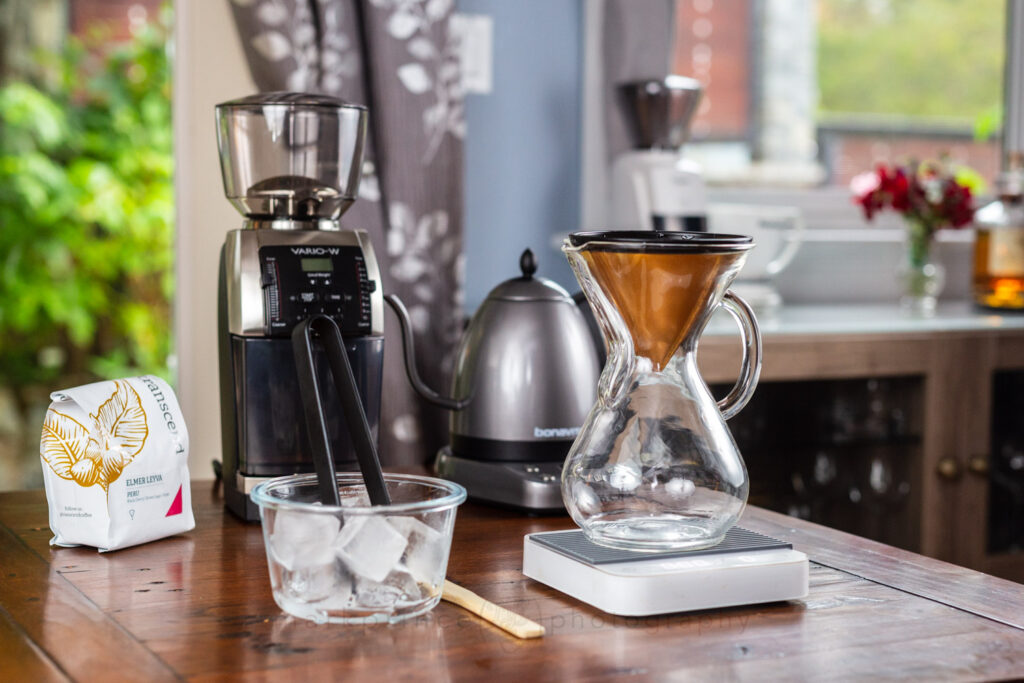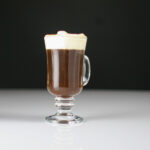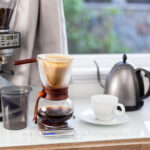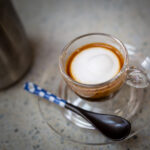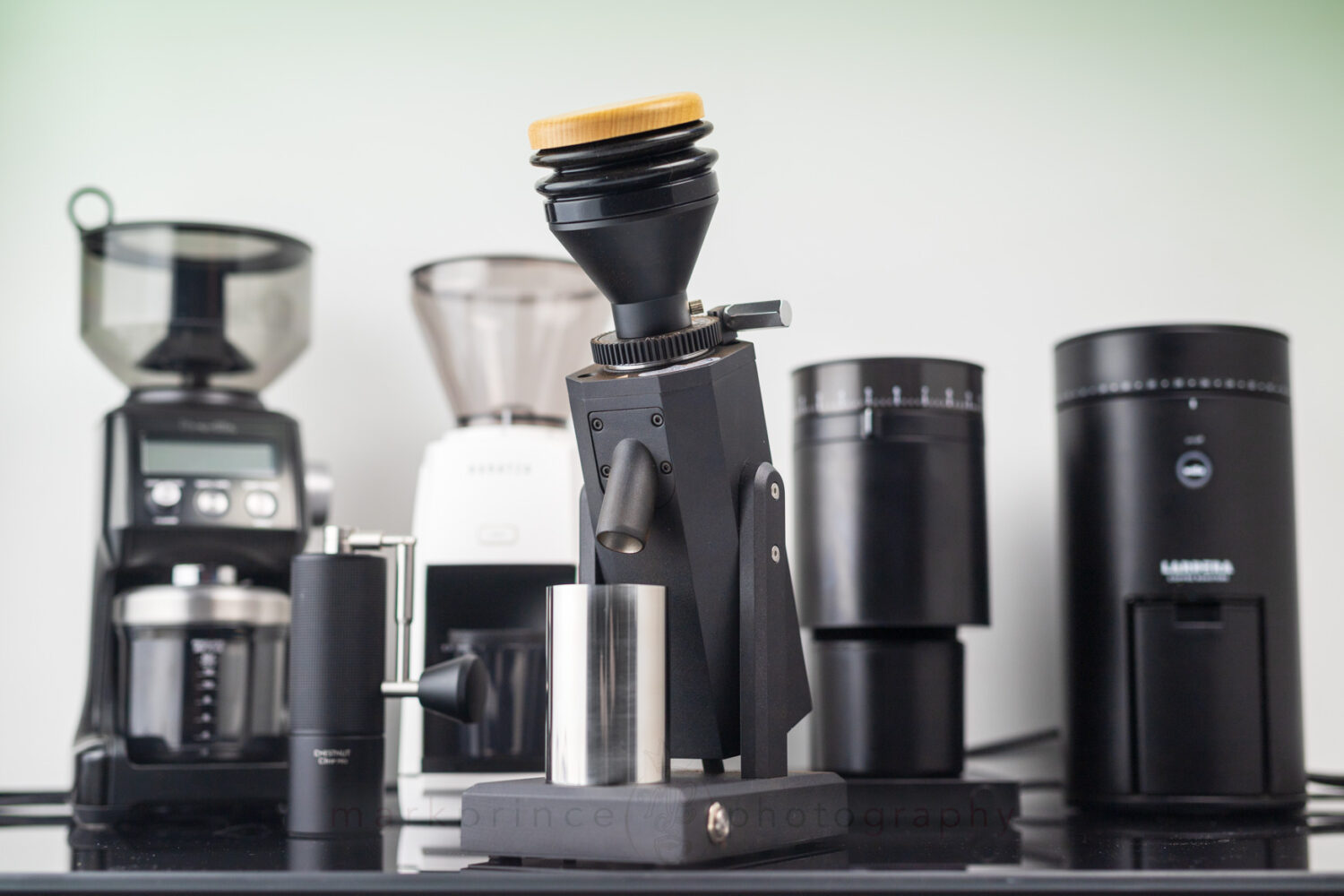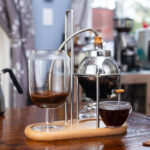Hario V60 Step by Step
Use this clear and fully described step by step guide to get a consistently excellent brew out of your Hario V60 filter brewing system. This How To assumes you already own a quality coffee grinder.
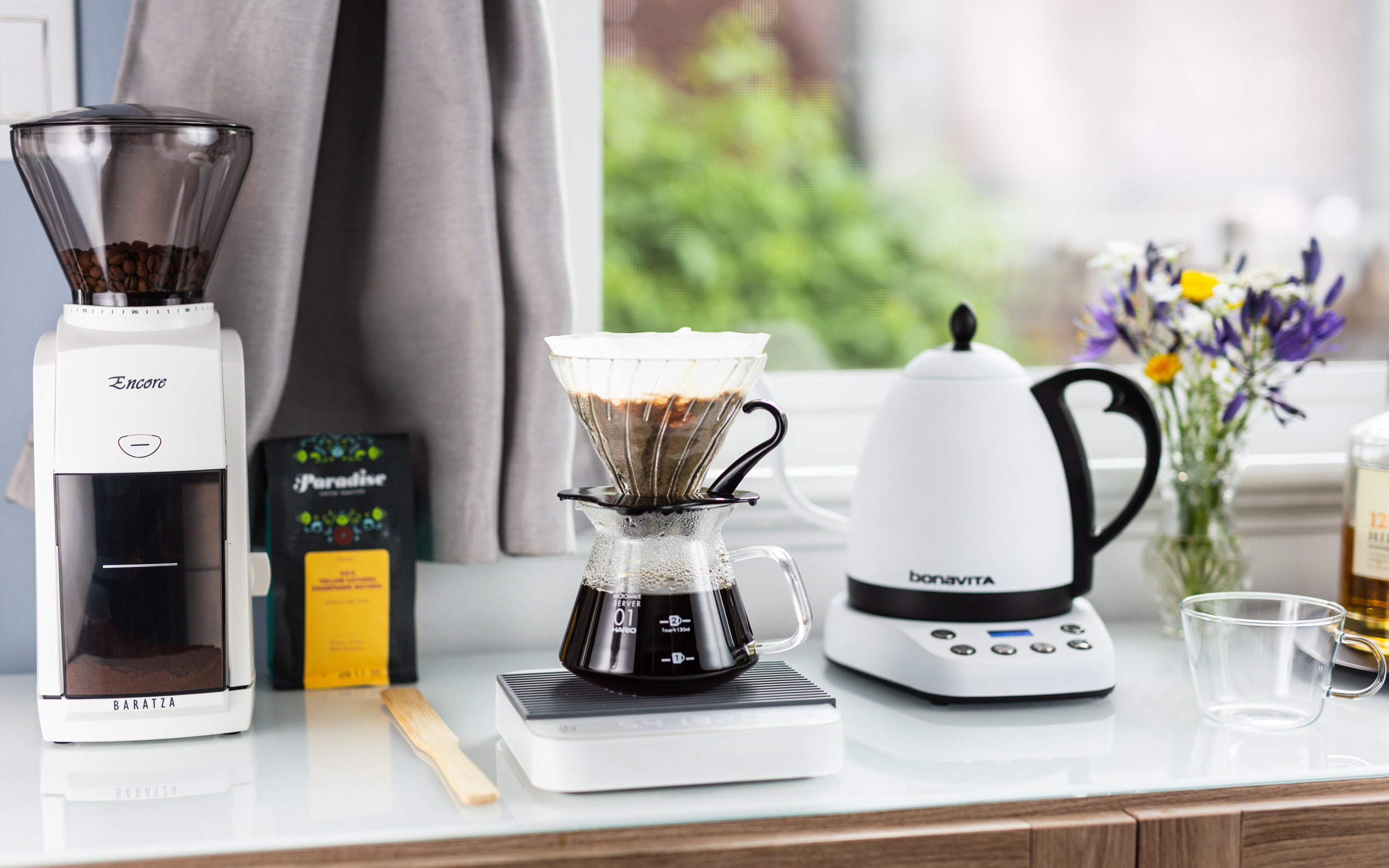
Time Needed: 10 minutes
Total Cost: $ 45
Required Supplies
Necessary Equipment
Necessary Steps
Shape Your Filter
V60 filters come flat, so you can put them into their starter cone shape by folding them opposite of the seam side; give them a pinch at the bottom and they’ll pop into their cone shaping.
Insert Filter
Take your V60 paper filter and place it inside the Hario filter holder; we’re using the 02 Glass Hario Filter Holder here.
Fire Up the Kettle
At this point, start up your kettle; a temperature-settings capable gooseneck kettle is your best option for pour over and that is the type we’re using for this How To.
Set Kettle to 205F (at sea level)
At sea level (or up to 1,000m above), 205F (about 96C) is a good starting point, if you have a temperature control kettle.
Optional - Stovetop Kettle
If you’re using a stovetop or non temperature-control kettle, just let the kettle come to a boil, and remove it from heat, time it so you use it about 2 minutes after. By that time, the water temperature will be down to about 205F or lower.
Rinse the Paper Filter
Paper filters greatly benefit from being rinsed, or “washed” with hot water; we usually run at least 300ml or more through the paper filter before using it to brew.
Grind Coffee, 7g per 105ml Water Used
Once the filter’s been rinsed and your kettle is to temperature, fire up your grinder and grind out approximately 7g per every 105ml of coffee you plan to brew.
Check Your Grind Fineness and Dose
The CoffeeGeek Standard Dose is to start with 7g coffee per 100ml of water used to brew; however, for V60 brewing, we use a bit less coffee: our ratio is 7g per 105 to 110ml brewed. We’re grinding 21g for brewing 330(ish) millilitres of coffee in this example. Note the granular size of the grinds (click to enlarge the photo); the Baratza Encore does an excellent grind for pour over, and our granule sizes are like slightly coarse salt.
Add Ground Coffee to Filter
At this stage, add your coffee evenly and well dispersed in the V60 filter.
Create Dimple - Optional Step
This is an optional step, but can help improve overall saturation, and the initial bloom phase: create a well, or dimple, in the middle of the coffee bed.
Pour At the Right Temperatures
At this point, your manual kettle should be about 2 minutes off the boil, and the water temperature in the kettle is around 203-206F If you have a thermometer, verify. You’re ready to brew.
Begin the Bloom Pour
The first stage of a V60 pour over coffee pour is pouring the “bloom pour” portion. This saturates the grounds, does an initial release of C02, and preps the coffee for it’s flow through brewing to come. We like to pour 1.5x grams of water compared to the dose of coffee; this is a 21g dose, so we’re pouring about 33 grams of water for the boom pour.
Pause for 30 Seconds
After your initial bloom pour (which takes about 10 seconds of the pour over timing), pause for about 30 seconds, before you begin your brewing pour.
Begin V60 Brewing Pour
Begin pouring your kettle water in a slow spiral mode. About 3-5g (3-5ml) of water per second is the ideal flow rate; to judge it, have a timer handy or watch handy.
Pour Half of the Total Brewing Volume
Continue pouring in a centrical pattern, tightening and expanding, to cover all parts of the bed of coffee. Optionally, you can pour up to half your total volume (for this example, pour about 170ml, or half of the 330-340ml brew), and pause for 15 seconds (not shown here), before continuing your pour.
Continue Pouring
If you optionally paused halfway through your pour, continue pouring now, always in a circular pattern. Make sure all the coffee is saturated and being extracted from.
Get 100% Even Coverage
Use your pour style to make sure all coffee in the filter gets even coverage.
Pouring Done, Brew Continues
At the 3:00 to 3:30 mark into brewing (for this volume of 320-340ml brewed), you should be done pouring. Remaining water keeps brewing for another 20-40 seconds.
Brewing Completed
The V60 pour over brew should be completed around the 4 minute mark, give or take 15 seconds, for this particular volume brewed. If you’re doing larger batches, the brew time might be 5 or even 6 minutes.
Discard Filter and Coffee
Discard the V60 brew filter with spent coffee: it’s an awesome addition for your home compost, as the spent coffee provides nitrogen, and the paper filter will break down and add to the compost makeup.
Hario V60History and Background
Hario’s an interesting company. Based out of Japan, their main claim to fame until recently was the glass they made — they’re essentially the “pyrex” and “corning” of Japan — and they’ve been making specialized glass for every industry, from car manufacturing to scientific labware, since the 1920s.
The company has also long dabbled in coffee and tea items, including glassware for drinking, and various apparatus for brewing and even roasting coffee. They introduced their first coffee siphon in 1949, and developed a glass coffee roaster — manually hand cranked! — in the late 1990s. Here’s just a few of the items the company has developed for coffee over the years:

Hario Glass Roaster
This is also a fully functioning device, made by Hario. Very easy to "tip" the beans in this, unless you're religious about the RPMs you hand cranks.
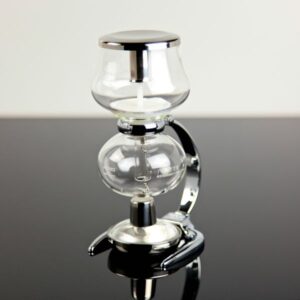
Hario Miniphon
The world's smallest functioning siphon coffee maker, a bit of a novelty
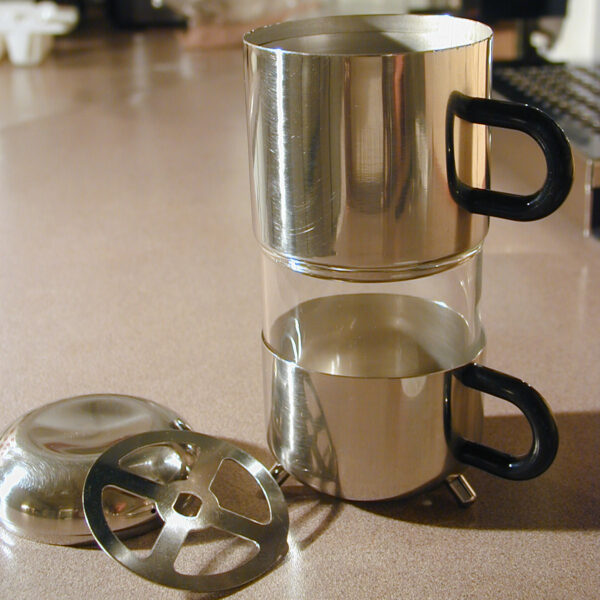
Hario Dripper
Very rare and obscure metal dripper setup from Hario, from the 1980s.
Hario initially developed a cone filter brewing system for coffee way, way back in the 1950s, but it was developed for true Japanese style of brewing, called Nel Drip (also known as cloth drip, and we wrote a How To on that – check it out!).
As auto drip and other filter drip methods developed in the 1970s, Hario developed another variant of the conical brewing filter and released a commercial design in 1980 that went nowhere.
By the early 2000s, Hario once again revisited this conical paper filter, and came up with some intriguing design changes, including the breakthrough spiral fluted ribs, or channels, built into the paper filter’s housing, and a redesign of the cone’s shape and diameter. And so, in 2004, they launched this new cone design as the Hario V60. And it’s been with us ever since, and in many variants, including inexpensive plastic, ceramic, glass and even copper and other more exotic materials. It is also available in several sizes, and the company has commercial models as well as a wide range of domestic versions. There’s even kettles in Hario’s lineup designed to look like some V60 brewing carafes.
Meteoric Riseof the Hario V60
It only took a few years for the V60 to become popular in Japan, and by 2009, two groups with a decent web presence in the USA discovered and started enthusiastically promoting the brewing device: Tom Owen with Sweet Marias and the guys who used to run the coffee blog (now a store), Barismo (here’s the WayBack Machine of their early blog entry on the V60 from February, 2009 (scroll down). Blue Bottle took a lot of credit for the introduction of the V60 into North American culture and coffee scene (as seen in this 2011 NY Times article), but it wasn’t Blue Bottle – it was these folks.
The CoffeeGeek community very quickly picked up on Barismo’s enthusiasm for the brewing device, and we had tons of forum discussions around 2009 and 2010. The first consumer-posted review for the V60 on our website was posted in December, 2009. By 2010, the brewer was showing up on vendor websites, and getting into a lot of hands.
We were demonstrating and teaching the brewing method and devices in the CoffeeGeek lab in 2010, and besides espresso and siphon coffee, it was the most popular brewing method and brewing device for most of our 2,500 visitors while the Lab was open.
By the time it got the mainstream press and push for Blue Bottle’s use in 2011, the brewing method was everywhere. And by 2012, the first brewing contests and championships with V60 systems started up — first at the local cafe level, and later on, more structured and organized multi-cafe contests. By 2013, the V60 was a defacto brewing standard in every “third wave” cafe. Certainly in Vancouver at that time, every “we want to be the best” cafe had it on offer as a brewing method. Classes were being taught, and the brewing device was so insanely popular that Chinese knockoffs started flooding the market.
The V60 spawned a huge market in pour over coffee; on top of the V60 knockoffs, competing devices from Japan, like the Kalitta pour over devices, started hitting the market and finding their own fans. To this day, the popularity of the brewing device, and pour over coffee in general, has been climbing.
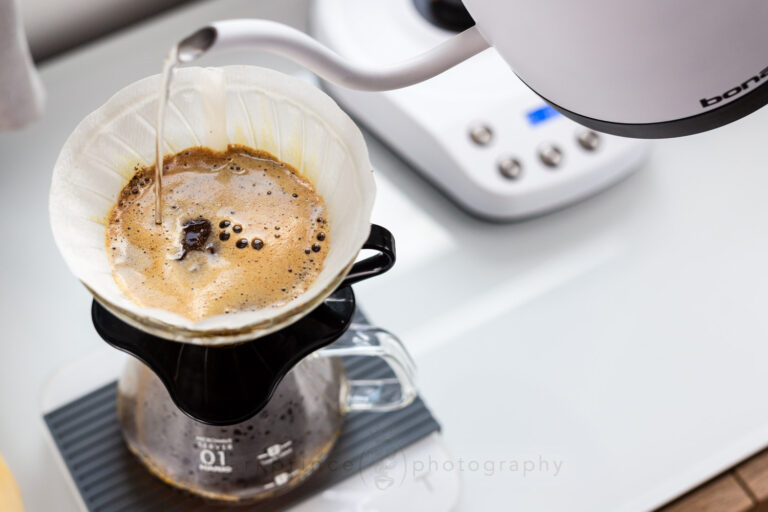
Brewing Coffee in a V60
Concluding ThoughsHario V60
The Hario V60 is an iconic brewing system that is arguably the most popular specialty coffee pour over device on the market today. It has spawned literally tens of thousands of YouTube videos on techniques (most, I have to say, are clones of each other and not very good), and a billion dollar market for clones, knockoffs, and competing products. The V60 has spawned ancillary markets too — like the market for pour over gooseneck kettles, digital scales with timers, and scientific looking carafes and beakers for brewing the coffee into — and there’s no sign of it slowing down.
The design of the V60 does make coffee better, there’s no doubt about that. It’s forced companies like Melitta, OXO, and even Chemex to look at their brewing devices and filters and make them function better for more even extraction. But at the end of the day, it is a paper filter system, and for what you get in convenience (very easy clean up), you do lose out on extraction: paper just does not allow the same level of non-soluble elements to make it into your cup that cloth or metal filtration does.
But as far as paper filtration methods go, the V60 system from Hario is a proven quality device, producing a quality cup, and millions of coffee aficionados, tens of thousands of coffee experts, hundreds and hundreds of barista and coffee brewing champions can’t be wrong when they say so and use the brewing system every day.

Support CoffeeGeek
If you enjoy and learn from this resource, please consider making a one time or recurring donation to help support our work and fund purchases for future reviews.















